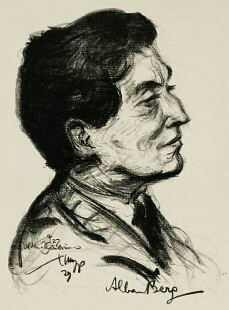
Einojuhani Rautavaara was a Finnish composer of classical music. Among the most notable Finnish composers since Jean Sibelius (1865–1957), Rautavaara wrote a great number of works spanning various styles. These include eight symphonies, nine operas and fifteen concertos, as well as numerous vocal and chamber works. Having written early works using 12-tone serial techniques, his later music may be described as neo-romantic and mystical. His major works include his first piano concerto (1969), Cantus Arcticus (1972) and his seventh symphony, Angel of Light (1994).

The Lyric Suite is a six-movement work for string quartet written by Alban Berg between 1925 and 1926 using methods derived from Arnold Schoenberg's twelve-tone technique. Though publicly dedicated to Alexander von Zemlinsky, the work has been shown to possess a "secret dedication" and to outline a "secret programme".

Ludwig van Beethoven completed his String Quartet No. 12 in E♭ major, Op. 127, in 1825. It is the first of his late quartets. Commissioned by Nicolas Galitzin over a year earlier, the work was not ready when it was scheduled to premiere. When it was finally premiered by the Schuppanzigh Quartet, it was not well received. Only with subsequent performances by the Bohm Quartet and the Mayseder Quartet did it begin to gain public appreciation.

The Viola Concerto, Sz. 120, BB 128 was one of the last pieces Béla Bartók wrote. He began composing it while living in Saranac Lake, New York, in July 1945. It was commissioned by William Primrose, a respected violist who knew that Bartók could provide a challenging piece for him to perform. He said that Bartók should not "feel in any way proscribed by the apparent technical limitations of the instrument". Bartók was suffering the terminal stages of leukemia when he began writing the piece and left only sketches at the time of his death.

Spring Song, Op. 16, is a single-movement tone poem for orchestra written in 1894 by the Finnish composer Jean Sibelius.

Ondine is a Finnish classical record label founded in 1985 in Helsinki, Finland. Its catalogue with several award-winning releases includes over 600 titles with major Finnish and international artists.
The String Quartet No. 2 in F major, Op. 22, by Pyotr Ilyich Tchaikovsky, was composed between December 1873 and January 1874. It premiered on 22 March 1874.
Introduction and Allegro for Harp, Flute, Clarinet and String Quartet is a chamber work by Maurice Ravel. It is a short piece, typically lasting between ten and eleven minutes in performance. It was commissioned in 1905 by the Érard harp manufacturers to showcase their instruments, and has been described as a miniature harp concerto. The premiere was in Paris on 22 February 1907.

The Missa Brevis by Leonard Bernstein is a musical setting of parts of the mass ordinary in Latin for a mixed a cappella choir with countertenor solo and percussion. It is also Bernstein's last complete choral work, due to his death a year after its completion in 1989.

The Octet for strings in C major, Op. 7, is an octet composition for string instruments by the Romanian composer George Enescu, completed in 1900. Together with the Octet in F major, Op. 17 (1849) by Niels Gade, it is regarded as amongst the most notable successors to Felix Mendelssohn's celebrated Octet, Op. 20.

The String Quartet in D minor, Voces intimae, Op. 56, is a five-movement chamber piece for two violins, viola, and cello written in 1909 by the Finnish composer Jean Sibelius. It is the only major work for string quartet of his mature period.

String Quartet No. 5 is the fifth of seventeen works in the genre by the Brazilian composer Heitor Villa-Lobos, written in 1931. A performance lasts approximately 17 minutes.

String Quartet No. 12 is the part of a series of seventeen works in the genre by the Brazilian composer Heitor Villa-Lobos, and was written in 1950. A performance lasts approximately twenty-two minutes.
Towards the Horizon is the second cello concerto by the Finnish composer Einojuhani Rautavaara. The work was commissioned by the Minnesota Orchestra under the direction of Osmo Vänskä. It was first performed by the cellist Arek Tesarczyk and the Minnesota Orchestra conducted by Osmo Vänskä in Orchestra Hall, Minneapolis, on September 30, 2010. The piece is dedicated to the cellist Truls Mørk, who was originally scheduled to perform the world premiere, but had to drop out due to health concerns.

Sonja Korkeala is a Finnish violinist and professor at the University of Music and Performing Arts Munich.

The Decet for winds in D major, Op. 14, is a chamber music work by the Romanian composer George Enescu, written in 1906 and first performed in Paris the same year. A performance lasts about 23 minutes.

The Gong on the Hook and Ladder or Firemen's Parade on Main Street, normally shortened as The Gong on the Hook and Ladder and also initially entitled Allegro moderato, is a short composition by American composer Charles Ives.

"Hymn: Largo cantabile", S. 84/1, sometimes also referred to as "Largo cantabile: Hymn" and often shortened as "Hymn", is a composition by American composer Charles Ives written in 1904. Grouped in the suite A Set of Three Short Pieces, it is published and commonly performed as a standalone work.

The Violin Sonatina in E major, Op. 80, is a three-movement duo for violin and piano written in 1915 by the Finnish composer Jean Sibelius. The main theme of the third movement was originally intended for the Sixth Symphony (Op. 104).

Einojuhani Rautavaara's Symphony No. 2, Op. 8, originally entitled Sinfonia intima, is a symphony for orchestra written in 1957. It marks the composer's departure from his neoclassical first symphony towards atonality.
















